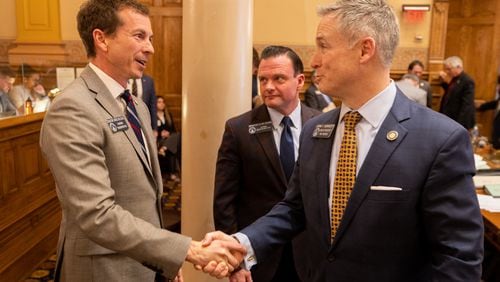In a new University of Pennsylvania ranking of factors that undermine college opportunities in each state, Georgia fares a bit better than might be expected. We’re far from the best for offering optimum college-going conditions, but we’re not at rock bottom with some other southern states.
The College Opportunity Risk Assessment is a big picture analysis of not only academics and post high school options, but state finances, education equity and higher education funding and productivity. The assessment considers 17 indicators, including how well a state prepares its high school students, how it engages non-traditional college students, how it supports minority students, and the state’s fiscal health and stability.
Georgia ranked 23rd among the states, which means students here face moderate risks and obstacles in the path to attaining a degree. (Georgia tied with Pennsylvania.)
“The world has changed, but our public policies haven’t,” said Penn researcher Joni Finney in a statement. “We’re still touting the successes of a system designed in the wake of World War II to allow 30 to 40 percent of the country, drawn mostly from white, affluent backgrounds, to earn a college degree even though that system now leaves us woefully unprepared for the challenges of the 21st century.”
The state with the worst ranking was Mississippi, followed by Montana, Alabama, South Carolina and Louisiana. The top slot went to Washington, followed by Vermont, Virginia, Iowa and Minnesota.
The educational opportunities that states make available to citizens and how easy they are to access are now critical because 60 percent of the U.S. workforce will need college degrees, workforce certificates, industry certifications, and other high-quality college credentials by 2025. In 2016, only 48 percent of Georgians held such credentials.
Georgia loses points – and thus poses higher risk to its students and their academic success – in educational performance, where it ranks 47th in the nation.
The report faults Georgia performance in national assessments in mathematics and reading, high school graduation and six-year college completion rates and the extent to which young adults and working-age adults enroll in educational programs beyond high school.
So, where does Georgia mitigate risks?
We have smaller gaps than most states in high school graduation and postsecondary completion between white students and students from all other racial and ethnic groups.
We rate high – sixth in the nation -- in the educational efficiency of degree-granting institutions, in terms of the number of workforce certificates and degrees awarded for every 100 full-time equivalent students.
We have less volatility of higher education appropriations than most states, ranking 14th.
Our state rainy day fund -- resources maintained to offset economic downturns – is stronger than the majority of states.
Here is the official summary of the report:
Rising tuition prices and student debt loads have come to dominate the debate over the future of higher education in the United States. But a new report from the University of Pennsylvania’s Graduate School of Education (Penn GSE) finds that in order to understand the obstacles to making college accessible and affordable, leaders must consider, but look beyond college sticker price and state appropriations.
The College Opportunity Risk Assessment includes a risk ranking for all 50 states, and an examination of where each state is most at risk. Among researcher Joni Finney’s findings:
Every state has a long way to go to have enough adult workers with college degrees, workforce certificates, industry certifications, or other high-quality college credentials to meet the economic and civic challenges of the 21st century. Many states cannot reach the demand for more credentialed and degreed workers by focusing only on young people. Even Washington state, which is least at risk in these rankings, is projected to fall more than a quarter million credentials shy of expected need by 2025.
States that are making the most per-student investments, and spending that money efficiently, are not in the clear. Despite besting the rankings in higher education funding and productivity, Arizona ranks 13th overall, and without significant changes, will struggle to produce enough graduates.
While many states in the southeast are the most at risk (Mississippi, Alabama, South Carolina and Louisiana all rank in the bottom 5), the lower half of the rankings covers the map. This reflects the lack of a national policy for improving access to college.
Wealth does not fully mitigate against risk. Connecticut has the second-highest median household income according to the US Census Bureau – but it ranks 44th here.
What should policymakers prioritize to get on track? Finney has these suggestions for most states including Georgia:
Prioritize students who have traditionally been left out of higher education. The nation cannot meet its educational needs by educating more mostly white 18-24 year olds. Low-income, first generation, minority, and working-adult students need to supported in ways that have not been seriously attempted on a large scale. Start by focusing support on the institutions that educate most Americans, such as community colleges and regional comprehensive colleges.
Rebalance the financial burden. Public colleges have more money flowing through them than ever before, but students are supplying a greater share of that revenue through tuition, while states' contributions have proportionally fallen. This is a recipe for dropouts and debt, not degrees.
Look beyond the education budget. States can't prioritize higher education opportunity based on improved educational performance and equity without stable funding to higher education, the productive use of funds, the development of state reserves for economic downturns, and policies to better manage state debt and public pension liabilities, as well as policies to encourage economic growth and knowledge-based industries.
Find partners. Governors, legislators, business leaders, and institutional leaders must collaborate more effectively than in the past few decades in order to put in place a public compact for educational opportunity that will serve states in the decades to come.
About the Author







